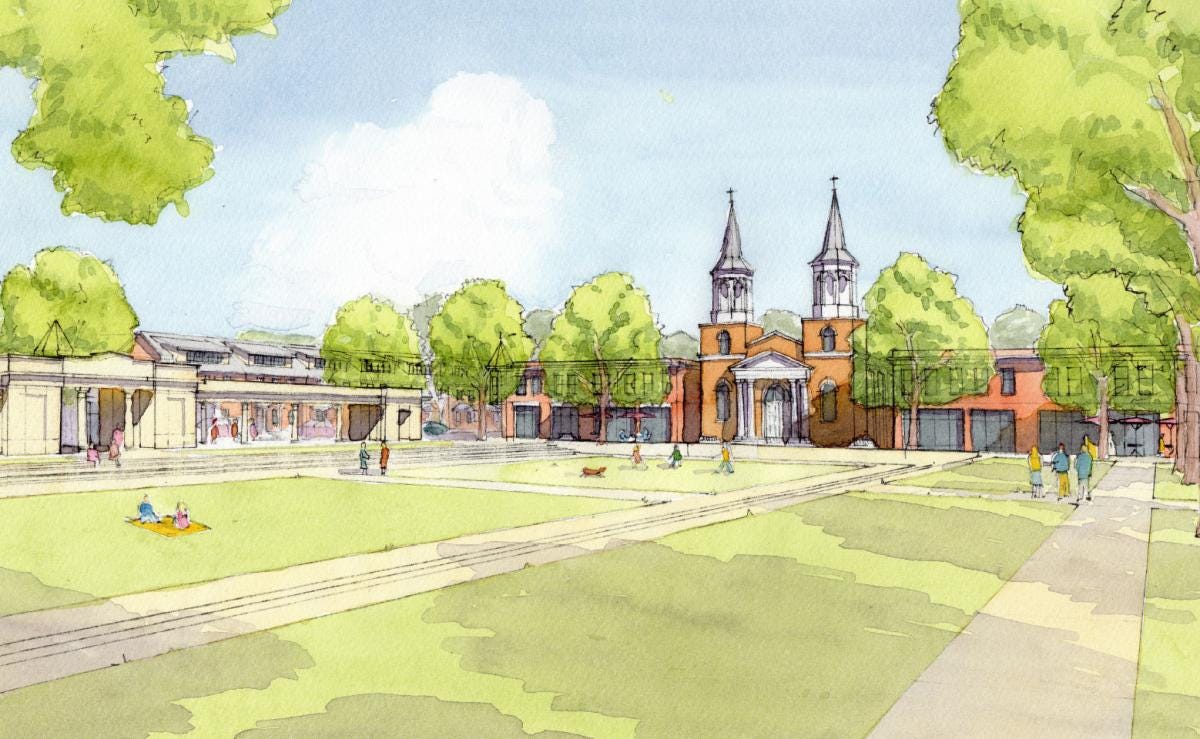Communion: Faith-Based Housing as Sacrament
In Detroit, Michigan, Sometimes seeing is believing, or building.
Written by Evan Bille Magen.
Happy New Year! In 2025, more faith communities will talk about the need for affordable housing in their cities. As this trend accelerates, I want to explore this question as the new year begins: which congregations are finding solutions?
And why have people of faith been reluctant to build housing on their own church campuses, and even more reluctant to support pro-housing policy in their broader community?

Has the Church lost touch? Relationally, sure, as neighborhoods changed around church properties in cycles of white flight, disinvestment, and gentrification. Theologically, yes, as public religious discourse has boiled down to sexuality and abortion.
Better writers use this language to illustrate the Church’s disconnection and alienation, but I believe the biggest stumbling block to faith-based housing is that churches have literally lost touch. It is the inability of congregations to see and feel a religious connection to the built environment.
That is not only a relational or theological issue, but a sacramental crisis.
Fr Alexander Schmemann argued that we exist in a sacramental reality. He explains that “the term ‘sacramental’ means that for the world to be a means of worship and a means of grace is not accidental, but the revelation of its meaning, the restoration of its essence, the fulfillment of its destiny.”1
The world around us is an “epiphany of God,” even as we do not recognize it. It is in the particular moments of celebrating Communion or Baptism that we see and feel God’s wider intention for all of creation. These practices are both insights into a promised future and present steps toward this sacramental reality.
These moments, as sacraments, are tangible signs of God’s promise. They take place in a worship service, but their effects impact the wider community. Communion and baptism provide a model of covenant community. We receive and extend grace over a common meal, welcome new members and vow to support them, all with an understanding that one’s place at the table or acceptance into the community is not based on our own merit or virtue. Not who we are, but whose we are.
Housing built on church campuses offers a similar sign. When churches develop permanent supportive apartments or ADA-accessible cottages, they model God’s care for the vulnerable spoken through Isaiah 1:17—
“learn to do good;
seek justice;
rescue the oppressed;
defend the orphan;
plead for the widow.”
When churches create a diversity of housing options, they offer abundance where there is currently scarcity. Churches can cultivate God’s vision of abundance in Micah 4:4, “they shall all sit under their own vines and under their own fig trees, / and no one shall make them afraid.”
Faith-based housing is a tangible sign of God’s intention for community. It models a vision of shared abundance and care for the most vulnerable, where safe and stable housing is not dependent on our own merit or virtue. Not who we are, but whose we are.
Faith-based housing, then, is a sacramental act.
Now before I get accused of heresy (from the church folks or the YIMBYs), I am not saying building housing is the same as the Lord’s Supper or Baptism. I am not advocating for a doctrine of drywall transubstantiation where Christ is present as a carpenter.
Rather, I believe the Church should take seriously its role as the vehicle and model of our sacramental reality. If our worship and the words we say reveal an essential truth of our world, then so should our spaces. If our fellowship and rituals model God’s intention for community, then so should our campuses.
According to Southern Urbanism Quarterly,2 faith communities gather and worship on more than 1,400 acres in Durham, North Carolina. Most of that land is underdeveloped, and zoning has historically restricted housing from being built on those properties. Under a new amendment to Durham’s Unified Development Ordinance (UDO), religious campuses will able to build an unlimited number of Accessory Dwelling Units (ADUs) on their property.
This amendment exemplifies how the Church can be a vehicle for pro-housing policies in cities. It starts in our congregations and on our church properties. Whether it is bread or brick, our faith calls us to live into the sacramental reality by touching and receiving elements of grace. May our open hands open our hearts and minds to new opportunities for communion.
Evan Bille Magen lives in Durham, NC and serves as a Chaplain Resident at the Durham VA Medical Center. He is a recent graduate of Union Presbyterian Seminary and candidate for ordination in the Presbyterian Church (PCUSA). This article was originally published on his Substack “Public Goods.”
1 Alexander Schmemann, For the Life of the World, (New York: St. Vladimir’s Seminary Press, 2018) 144.
2 I owe a lot of this article to the good folks at Southern Urbanism Quarterly. I am so excited to see their projects coming in the future!


